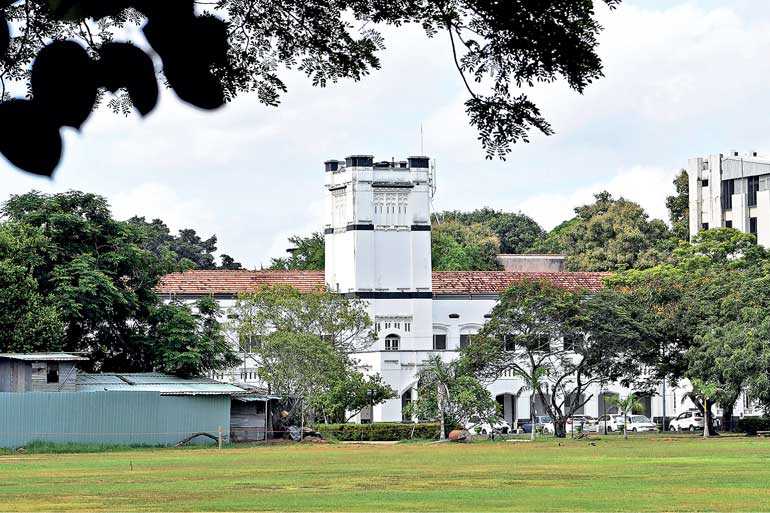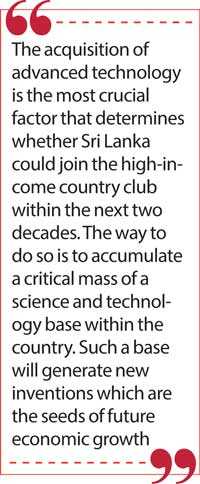Monday Apr 07, 2025
Monday Apr 07, 2025
Monday, 12 October 2020 00:10 - - {{hitsCtrl.values.hits}}

The Government should set up many more techno cities all around the country with participation of both State and private universities, research institutions and industrial ventures – Pic by Shehan Gunasekara
A Chinese tech-university is a good development
It has been reported in the media that President Gotabaya Rajapaksa had requested the visiting high-level delegation from China to help establish a tech-university in Sri Lanka
(available at: https://economynext.com/sri-lanka-president-asks-china-to-reduce-trade-deficit-invest-in-tech-university-74651/?utm_campaign=EconomyNext%20News&utm_medium=email&utm_source=Revue%20newsletter). This is a salutary development on several counts. 
First, China is a leader in technology and its universities are moving up in the league table of renowned universities in the world year after year. Second, Sri Lanka has now been downgraded from a higher middle-income country to a lower middle-income country on account of its poor economic performance in 2019. With the economic downfall arising from the COVID-19 pandemic, Sri Lanka is going to live in this lowered status at least in the next few years. Thus, it has been a stumbling block for the country to reach its goal of becoming a rich country in a single generation.
Third, during the previous Yahapalana Government as an important component of its Megapolis Project, a techno city has been set-up in Pitipana, Homagama with the joint participation of local universities and industry. Already, the University of Sri Jayewardenepura has moved its Faculty of Technology to Pitipana site. Universities of Colombo and Moratuwa are expected to follow suit soon.
From industry side, one of the pharma companies, JL Morrison, has set up a state-of-the-art new manufacturing facility there. Hence, if a Chinese tech-university comes to Pitipana, it will not only create a healthy competition among universities concerned but also support the local and international private sector industry that chooses to set up their incubation centres in the place. Hence, this is a move to be supported by everybody.
Need for carrying it to a fruition
However, the caveat is that it should not remain just a wish of the authorities. The previous Yahapalana Government too made a similar request from India to establish a branch of its world-famous Indian Institutes of Technology or IITs in Sri Lanka. But this was not carried to a fruition and, hence, it just remained a wish of the authorities. The other point is that if Sri Lanka is to become a hub of higher learning, the country should invite not only universities from China but also those of other countries, notably, India, UK and Malaysia to setup branches here. Such a diversified presence of world-famous universities on Sri Lankan soil will certainly help the country to regain its old glory of being a hub of learning and knowledge.
Technology is needed to beat the middle-income trap
One problem which Sri Lanka faces in its journey toward a rich country is the possibility of getting snared in what is now known as ‘the middle-income country trap’. Sri Lanka became a lower middle-income country in 1997 but even after 23 years, it still remains in that state. The middle-income trap can be elaborated as follows: A poor country with its abundant cheap labour could produce labour intensive products for the rest of the world and move up in the ladder to become a middle-income country. However, it will get stuck as a middle-income country forever due to two reasons.
One is that it no longer can compete with the newcomers to the labour-intensive product market because of the increase in its wage levels, a corollary of moving into the middle-income level. The other is that it cannot compete with rich countries because it does not have the required high technology to do so.
Thus, the acquisition of advanced technology is the most crucial factor that determines whether Sri Lanka could join the high-income country club within the next two decades. The way to do so is to accumulate a critical mass of a science and technology base within the country. Such a base will generate new inventions which are the seeds of future economic growth.
Inventions should be converted to commercial products via innovation
However, inventions alone are not sufficient for a nation to move forward. The Austrian-American economist, Joseph Schumpeter, in his 1911 book The Theory of Economic Development, made a fine distinction between invention and innovation. Invention is a creation of a new idea, product or service. It is the people with brain power who would do so by getting continuously engaged in research and development. Thus, the scientific research is the base of new inventions. 
But inventions per se will not help a nation. Such inventions must be converted into commercially viable goods and services for use by people. That task is accomplished by a group of people known as entrepreneurs. Schumpeter called this process ‘innovation’. Innovators would examine the market viability of inventions, mobilise the needed resources, take the risk and produce a usable good or a service. Thus, without innovators, inventions would just remain an idea put to paper by a researcher or a prototype product that could be replicated through a manufacturing process.
Example 1: Apple Macintosh Desktop computer
Just two examples from the recent past would clarify this point. The first Apple Macintosh Desktop was created by an engineer-inventor called Stephan Wozniak. It would have remained a prototype machine had it not been for the intervention of an entrepreneur called Steve Jobs. He mobilised resources through venture capital financing, organised the production process in the form of an enterprise, developed supply and market chains and created a brand name for Apple products. The result was the creation of a new product by destroying an existing manufacturing process. Schumpeter called it an instance of creative destruction.
Example 2: Gorilla Glass in smart phones
The other example too relates to a subsequent Apple product called iPhone, the smart mobile phone introduced by Steve Jobs to the market in 2006. The phone had a screen that had to be swiped with fingers when one uses it. Hence, the screen should be both scratch-free and break-free. When Steve Jobs made inquiries, it was found that another US Company called Corning Inc. had in 1960 created a glass called ‘Gorilla Glass’ for use by the US Air Force in fighter jets. However, the US Air Force had not used it and remained a prototype creation since 1960. When Steve Jobs, the innovator, found that the Gorilla Glass was the ideal glass for the screen of iPhone, Corning Inc., the inventor, began to produce it on a massive scale. Accordingly, an invention that had remained idle for 45 years was put to use by an innovator called Steve Jobs. With that of course, all smart phone manufacturers have now started using Gorilla Glass for the screen of the phones they are manufacturing. That has given birth to a world-wide new industry.
Creating a common future through technology
Thus, inventions and innovations should go hand in hand if inventions are to serve people. Inventions are done by scientists, people who work in research institutions or universities. They are the products of scientific research. That scientific research creates new technology. Hence, science, technology and innovation are three brothers who cannot be separated from each other. This was evident when South Korea hosted a few years back the OECD sponsored World Science and Technology Forum with an inspiring tagline. That is ‘Creating our common future through science, technology and innovation’. In today’s context, this should be the tagline for Sri Lanka too.
The curse of producing simple products
Sri Lanka’s current production mix is based on simple technology. The Economic Complexity Index compiled by Harvard University and Massachusetts Institute of Technology has ranked Sri Lanka as a simple product producing country since 1995. Accordingly, for all these years, about 98% of Sri Lanka’s exports has been based on simple technology. The danger of such a product mix is two-fold.
First, any other simple product producing country can compete Sri Lanka out in the world markets. This has already manifested in Sri Lanka’s garment industry which is facing stiff competition from newcomers like Bangladesh or Myanmar. Second, Sri Lanka will not be able to break away from the middle-income country trap with only simple technology available. Hence, scientific research should generate not only new inventions but also complex inventions which cannot be copied by others easily. This is the crucial challenge the country’s research institutions are facing today.
Produce for a bigger market
Sri Lanka’s internal market is limited in size, capacity income and outreach. Hence, it has to capture a market bigger than the domestic market if it is to beat the middle-income trap. This is the policy thrust followed by countries in East Asia such as South Korea, Singapore, Taiwan and Hong Kong that joined the rich country club within a generation. They were able to avoid the middle-income country trap successfully. But how? By building a gigantic research pool within them by using more and more resources on research and development every successive year.
According to World Bank data, both Singapore and South Korea, two science and technology powerhouses today, have been spending through both the public and private sectors about 2% of GDP continuously on Research and Development. This should be compared with Sri Lanka’s expenditure on same amounting to about 0.1% of GDP. Obviously, Sri Lanka should increase its expenditure on Research and Development to a higher level if it is to realise its target of producing for a market bigger than the national market. It is suggested that when the country progressively increases its expenditure on education to 6% of GDP over the next decade, 2% of that expenditure should be allocated to Research and Development.
Link researchers to industrialists
But will that be sufficient? No, because it should be accompanied by another element, namely, innovation. Research and Development or in other words, Science and Technology, should be linked to innovation, the process by which entrepreneurs convert the product of science and technology to commercially viable products. For that, research institutions, including universities, should be linked to industry. This linkage has been attained by other countries by establishing special research towns served by industry.
The Sheffield example
Among many, one of the examples for this new model is the Advanced Manufacturing Facility set up around the University of Sheffield, UK with many giants of industry and commerce being located there. The need for establishing such advanced manufacturing facilities has arisen due to sheer necessity: The need for competing successfully with low-wage and low-cost countries. Hence, it is necessary for advanced economies to bring out continuous innovation of production and processes involved in manufacturing.
To do so, they must engage in applied research, investment in sophisticated plant, technology and investment, automation of manufacturing processes through robotics, and developing a highly skilled workforce. All these four requirements are now met in one location where industry has been linked effectively to research and knowledge creation.
Regaining the old glory of Sheffield by being a thought-producer
Sheffield had been famous for quality steel products for decades. It was such a popular world brand, instead of calling ‘Made in England’, steel product manufacturers in Sheffield were successful in developing their own brand name, ‘Made in Sheffield’. Like Ceylon Tea, it instantly denoted quality and reliability. This was not be for long after Sheffield began to experience fierce competition from other countries that also went into the same production line such as Japan, South Korea and now China. Consequently, Sheffield lost its glamour as well as economic base.
Now to regain that lost glamour and lost economic base, Sheffield has established an Advanced Manufacturing Park around its University which functions as the key knowledge creator. It provides advanced manufacturing companies with industrial expertise, cutting-edge machines and equipment and solutions to complex industrial issues. More than 100 giant manufacturing companies including Boeing, Rolls-Royce, BAE Systems, Hitachi and Tata are in Sheffield Park.
Along with these giants, many small and medium size start-up research developers have also been set up in the Park in an incubator facility so that they could benefit from the practical exposure they would get by being in the Park. In addition, apprenticeship is provided to young workers to train them on the job thereby demonstrating that, to be creative and skilled, one need not have to acquire a four-year university degree.
Like the Sheffield Advanced Manufacturing Park, advanced research towns have been established around almost all the leading universities in USA. MIT, Washington and Boston are some examples.
Don’t abandon
the techno city project
What lessons are there for Sri Lanka to learn from these examples? Many. The previous Yahapalana Government wanted to convert the whole of the Western Province into a Megapolis of Techno Cities. Though the term Megapolis is not used, its offshoot Techno City has not been abandoned by the present Government. It was evident from the Prime Minister Mahinda Rajapaksa, accompanied by his senior ministers, cutting the ribbon when opening the JL Morrison’s pharma manufacturing facility at Pitipana recently.
This is a salutary development from the point of the country’s move toward becoming a nation of science and technology. So, the Government should set up many more techno cities all around the country with participation of both state and private universities, research institutions and industrial ventures. In this context, the new research facility of Industrial Technology Institute or ITI at Malabe should be used fully for the benefit of the country. Its biotechnology unit has invented a number of new bioproducts that could be commercially produced if it is linked with industry properly. Setting up of another techno city around ITI’s Malabe facility is a good idea to be pursued.
Linking with world-famous research institutions
There is another way to improve the development of technology in Sri Lanka. That is to link the local research and technology development institutions to world famous such institutions. Such a move will help Sri Lanka to get technical assistance, develop collaborative research and technological inventions and upgrade the quality of its research facilities to match the world standards. A good candidate in this connection is the Colombo Port City Project, now nearing completion. It could build a world-class techno city of its own. Land could be allocated to host a leading foreign university and build around it an industrial town like the one built in Sheffield in the UK. That is the way to absorb the Colombo Port City seamlessly to the national economy.
Get ready for Industry 4.0
The world has already moved to the Fourth Industrial Revolution, designated Industry 4.0. The move was started in Germany in 2011 when the German Government decided to overhaul its industry for the future by applying what is now known as ‘Internet of Things’ or IoT to across industries. IoT will fix every gadget, machinery or equipment with internet sensors equipping them with capacity for teleoperation. Thus, future cars will be tele-driven, washing machines tele-operated and surgeries tele-performed.
When Sri Lanka changes its research thrust, it must reckon the new developments that are taking place in the rest of the world and prepare itself for the challenges it poses to the country. In that way, Sri Lanka can become an active partner in the global economy, rather than remaining a laggard.
(The writer, a former Deputy Governor of the Central Bank of Sri Lanka, can be reached at [email protected].)
Discover Kapruka, the leading online shopping platform in Sri Lanka, where you can conveniently send Gifts and Flowers to your loved ones for any event including Valentine ’s Day. Explore a wide range of popular Shopping Categories on Kapruka, including Toys, Groceries, Electronics, Birthday Cakes, Fruits, Chocolates, Flower Bouquets, Clothing, Watches, Lingerie, Gift Sets and Jewellery. Also if you’re interested in selling with Kapruka, Partner Central by Kapruka is the best solution to start with. Moreover, through Kapruka Global Shop, you can also enjoy the convenience of purchasing products from renowned platforms like Amazon and eBay and have them delivered to Sri Lanka.
Discover Kapruka, the leading online shopping platform in Sri Lanka, where you can conveniently send Gifts and Flowers to your loved ones for any event including Valentine ’s Day. Explore a wide range of popular Shopping Categories on Kapruka, including Toys, Groceries, Electronics, Birthday Cakes, Fruits, Chocolates, Flower Bouquets, Clothing, Watches, Lingerie, Gift Sets and Jewellery. Also if you’re interested in selling with Kapruka, Partner Central by Kapruka is the best solution to start with. Moreover, through Kapruka Global Shop, you can also enjoy the convenience of purchasing products from renowned platforms like Amazon and eBay and have them delivered to Sri Lanka.